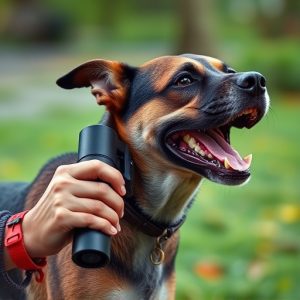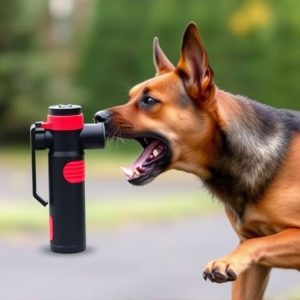Dog Spray Permits USA: Science, Safety, & Effective Animal Control Strategies
Dog spray (mace spray) in the USA is governed by state-specific permit regulations for animal contro…….
Dog spray (mace spray) in the USA is governed by state-specific permit regulations for animal control, emphasizing responsible deployment and public safety. Obtaining a permit involves training, proof of identity, and current information. Science behind dog spray repellents includes capsaicin or synthetic ingredients causing discomfort to animals. Legal considerations and safety precautions like training, gear, ventilation, and understanding range/effects are crucial. Beyond immediate deterrents, long-term strategies aligning with local regulations and community engagement reduce animal control conflicts ethically.
“Unleashing effective animal control solutions, we explore the potent tool of mace spray, particularly its role in managing canine interactions. ‘Understanding Mace Spray for Animal Control’ provides a detailed insight into this non-lethal method, demystifying its operation and safety protocols. With a focus on US regulations, our article delves into the ‘Dog Spray Permit Requirements’ governing its use. From scientific effectiveness to legal considerations, we offer a comprehensive guide, supplemented with strategic alternatives for holistic animal control management.”
- Understanding Mace Spray for Animal Control: A Comprehensive Overview
- Dog Spray Permit Requirements in the USA: Unraveling the Regulations
- The Science Behind Animal Repellent Sprays: How They Work
- Legal Considerations and Safety Precautions for Using Dog Spray
- Effective Strategies for Animal Control: Beyond Just Spray
Understanding Mace Spray for Animal Control: A Comprehensive Overview
Mace spray, specifically designed for animal control, is a non-lethal deterrent that has become an essential tool in managing aggressive wildlife and domestic animals. Its effectiveness lies in its ability to temporarily incapacitate or disorient targets without causing permanent harm, making it a popular choice for both professional animal control officers and homeowners facing pest issues. The spray contains capsaicin, the compound responsible for the burning sensation associated with chili peppers, which irritates the eyes, nose, and respiratory system of animals, leading to temporary disorientation and retreat.
In the USA, the use of dog spray or mace spray for animal control is regulated by specific permit requirements. These permits ensure that individuals and businesses employ these powerful tools responsibly, minimizing potential risks to both humans and animals. Understanding these regulations is crucial before deploying mace spray, as it involves knowledge of local laws, obtaining necessary permits, and adhering to safety guidelines to prevent accidental harm and ensure effective animal control.
Dog Spray Permit Requirements in the USA: Unraveling the Regulations
In the United States, the use of dog spray (also known as mace spray) for animal control is regulated by specific permit requirements that vary from state to state. These regulations are designed to ensure public safety and responsible usage of such devices. Generally, individuals or organizations seeking to employ dog spray must obtain a permit, undergo training, and comply with stipulated conditions. The Dog Spray Permit Requirements in the USA involve several key steps.
First, prospective users often need to demonstrate proficiency in handling and using the spray through certified training programs. Additionally, permits typically require applicants to provide proof of their identity and the legitimate purpose for employing dog spray, whether it’s for professional animal control services or personal protection against aggressive dogs. Some states may also mandate regular renewals and updates to ensure the information on file remains current.
The Science Behind Animal Repellent Sprays: How They Work
The science behind animal repellent sprays, such as dog spray, is grounded in a combination of chemical and olfactory cues. These products typically contain active ingredients that emit strong scents or irritants designed to deter animals from specific areas. For instance, many dog sprays use capsaicin, the compound responsible for chili peppers’ heat, or synthetic versions thereof, to create an unpleasant experience without causing significant harm. The mechanism involves the spray’s volatile compounds mixing with moisture on an animal’s fur or skin, leading to irritation and a strong, lasting scent that animals associate with danger.
In the USA, dog spray permit requirements vary by jurisdiction, but they generally involve understanding local laws and ensuring responsible use. This includes knowing the legal restrictions on where and how such sprays can be deployed, as well as training in their safe and effective application. Understanding these science-backed principles and adhering to regulatory guidelines are essential for humane and successful animal control using repellent sprays.
Legal Considerations and Safety Precautions for Using Dog Spray
Using dog spray for animal control, especially in public spaces, comes with a set of legal considerations and safety precautions that must be adhered to. In the USA, there are specific permit requirements for carrying and using dog spray. Not all states have similar regulations, so it’s crucial to understand local laws before deploying this method. Some areas may require permits or registration for both the spray and the person carrying it, ensuring accountability and minimizing misuse.
Safety precautions are paramount when handling dog spray. Users should be trained in its application to avoid accidental harm to bystanders, pets, or wildlife. Protective gear, including gloves and eye protection, is recommended during use. Proper ventilation is also essential, especially in enclosed spaces, to prevent the accumulation of aerosolized chemicals. Understanding the range, effects, and deactivation time of the spray ensures safe and effective animal control practices.
Effective Strategies for Animal Control: Beyond Just Spray
Animal control is a complex issue, and while mace spray may be a popular solution, it’s just one piece of the puzzle. Effective strategies go beyond immediate deterrents like dog spray, focusing on long-term solutions that address the root causes of animal disturbances. Understanding local regulations, such as permit requirements for dog sprays in the USA, is crucial for responsible use and community safety.
Community engagement and education play a vital role in humane animal control. Encouraging pet owners to properly train their animals, securing trash cans to prevent food attractants, and promoting co-existence with wildlife through knowledge and understanding can significantly reduce conflicts. Additionally, working with local authorities and animal welfare organizations ensures that responses are well-coordinated, respectful of all parties involved, and consistent with ethical practices.
Mace spray animal control, while a powerful tool, is just one piece of the complex puzzle that is effective animal management. As we’ve explored, understanding the science behind repellent sprays and adhering to legal guidelines for their use are essential. Navigating the Dog Spray Permit Requirements in the USA is crucial for responsible application. Beyond spray, adopting comprehensive strategies that include education, habitat modification, and humane trapping methods can foster a more sustainable and effective animal control approach. By combining these tactics, communities can address wildlife conflicts while minimizing harm to both animals and humans.


